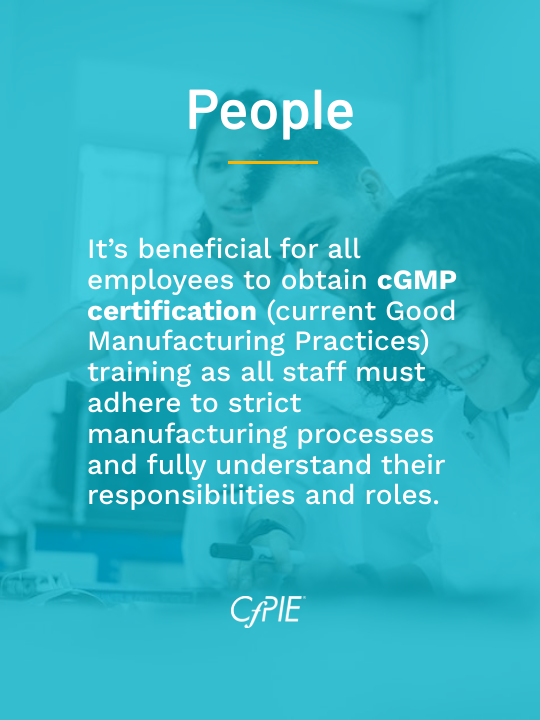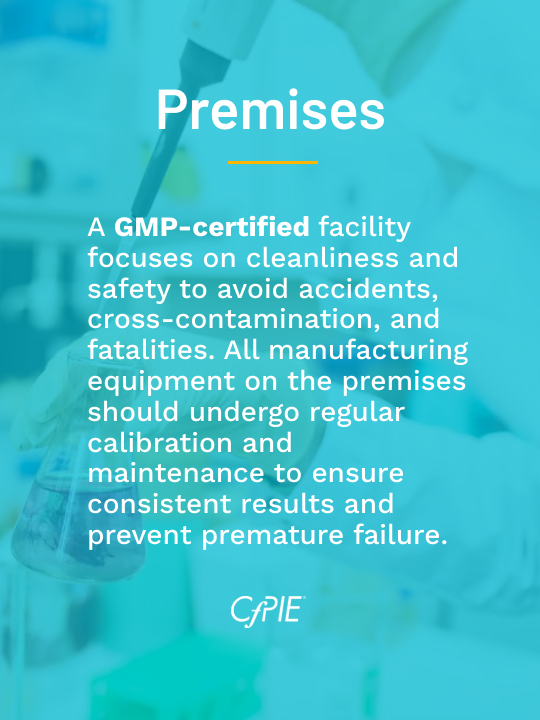How to Obtain GMP Certification for Your Manufacturing Facility
Key points to obtain and maintain GMP certification:
- Train and educate employees
- Develop and implement standard operating procedures in your manufacturing facility
- Analyze your current practices to ensure they align with FDA and/or EMA regulatory guidelines
- Create a strong quality management system
- Conduct Internal Audits and Inspections
- Continually assess and make improvements

GMP certification is crucial to the success of any manufacturing facility as it identifies you as a dietary supplement and pharmaceutical manufacturer fully compliant with FDA (Food and Drug Administration) regulations. It also shows that you have the required systems and use established quality standards and controls.
Industries that manufacture products usually consider all aspects before choosing a manufacturing facility, including the idea that consumers view medicinal products with GMP certification labels as having higher quality and are more trustworthy.
While you may understand the importance of Good Manufacturing Practices certification, do you know what it takes to become GMP Certified and stand out from the competition? Read on to learn everything you need to obtain GMP certification for your manufacturing facility.

What are the Requirements for GMP Certification?
GMP certificate standards and guidance require proper design, monitoring, and control of manufacturing facilities and processes, to ensure it meets regulatory authority's standards. The five main components of GMP help manufacturers comply with requirements throughout production: People, Products, Processes, Procedures, and Premises.
Recommended read ->
5 key components of Good Manufacturing Practices
Obtain and Maintain Your GMP Certification
Industry standards and technologies are constantly changing, so GMPs must adapt and evolve with them. Staying up-to-date with the latest FDA guidelines and regulations will keep you compliant and ensure quality products.
Develop and Implement Standard Operating Procedures
Standard Operating Procedures (SOPs) are crucial to maintaining consistency and regulatory compliance. Everyone must be on the same page regarding procedures, or results will vary. Standard Operating Procedures ensure manufacturers have control of manufacturing processes, have a structured quality system with qualified employees and an encouraging company culture.
There are seven steps to develop and implement effective SOPs:
Step #1: First Draft
Create a detailed list of everything you need to complete a particular process in sequential order.
Step #2: Planning
Review your list and ask questions such as:
- How is the procedure done?
- Why is it done that way?
- How can an SOP improve it?
- How can you measure its performance?
Step #3: Internal Review
Give your first draft to the employees who perform the task to get valuable input.
Step #4: External Review
Seek professional advice from technical advisors, including nutritionists, veterinarians, or extension agents. They may advise on the best way to manage specific steps and, if applicable, revise your procedure accordingly.
Step #5: Testing
To avoid bias, choose an employee unfamiliar with the process to test your procedure by following the steps precisely, then revise as necessary.
Step #6: Final Draft
With all testing complete, create a final draft of the standard operating procedure and ensure all employees are familiar with it.
Step #7: Training
Train all employees who impact production on the new employee practices and highlight the importance of following the procedures precisely.
Conduct a Gap Analysis
A gap analysis is a comparison of your current practices to the regulatory guidelines to help identify if any gaps exist. If your SOPs fall short, you must correct these gaps.
Performing a gap analysis is vital for GMP compliance and should include the following areas:
- SOPs
- Validation procedures
- Laboratory practices
- Risk assessment
- Data integrity
- Documentation practices
- Distribution practices
- And more
Identify Areas of Improvement Through the Six Steps of Gap Analysis
Test your regulatory compliance by performing six steps:
- Identify gap areas: Choose the areas you wish to analyze for gaps and gather the appropriate departmental regulatory documentation. List each area, such as protocols, SOPs, and systems.
- Prepare a checklist: Create a checklist of every step in the procedure that delivers the desired result.
- Gap analysis: Visit the area of the facility where the process takes place and document each step the employee performs to complete the audit process.
- Identify the gaps: Record the differences (gaps) in your regulatory list and the list from the current processes. Where there’s a gap, there’s a risk to product quality. Rate the severity of the risk as low, medium, or high.
- Corrective action: Provide a corrective action for every gap according to the regulatory documentation. Issue a copy of the corrective action to the offending department with a deadline corresponding to the severity level, such as 30 days for low risk, 15 days for medium risk, and 7 days for high risk.
- Implementation review: Review the results of the corrective actions and record the status
Establish a Robust Quality Management System
A robust quality management system (QMS) is essential for ensuring compliance with regulatory requirements in the manufacturing industry. An effective QMS enhances product safety and quality, mitigates risks, drives consistency and standardization, builds confidence and trust, and enables continuous improvement.
There are seven key components when implementing your QMS.
- State your quality policy and objectives: A quality policy is the framework of your QMS. It states your mission, purpose, and commitment to continuous improvement and regulatory compliance. Quality objectives are measurable goals for product performance, safety, efficiency, customer service, and more.
- Quality manual: The manual includes regulatory compliance requirements, processes, policies, and more, documenting the scope of the QMS.
- Organizational responsibilities and structure: A flow chart can outline the responsibilities of infrastructure, stakeholders, and resources required to achieve objectives.
- Internal processes: Establish metrics to measure the performance of defined processes ensuring quality products.
- Customer satisfaction: Use surveys, reports, and website reviews to monitor customer satisfaction with product quality.
- Continuous improvement: Follow the Plan-Do-Check-Act (PDCA) cycle to ensure continuous improvement. Plan: Identify improvement opportunities and plan for change. Do: Implement small-scale change. Check: Analyze change results utilizing data. Act: If successful, implement the change on a broader scale or start the cycle over if not.
- Document control: Have a procedure or policy in place for the review, storage, retention, identification, retrieval, protection, and disposal of documents.
Train and Educate Employees
Training and education are compulsory requirements for GMP certification. This can include various methods such as:
- E-learning courses
- Classroom sessions
- Webinars
- Games
- Podcasts
- And more
CfPIE’s GMP certification course provides your employees with:
- Highly qualified life science instructors: Delivering a unique blend of adult learning principles with current industry experience.
- Convenient course formats: Choose on-site classroom sessions or interactive virtual ones to suit your schedule.
- Industry-recognized certification: The medical device and pharmaceutical industries widely recognize CfPIEs 12 life science Certification Programs.
- Knowledgeable training advisors: Trained advisors help you navigate certification, training, and discount options.
Conduct Internal Audits and Inspections
GMP audits and inspections ensure the safety, regulatory compliance, and quality of your products and processes. They’re essential in identifying and correcting gaps in your GMP system.
Here are some basic guidelines for conducting audits and inspections effectively:
- Know your scope and purpose so you can focus attention on the more critical and relevant aspects of your GMP system
- Follow regulations and guidelines that apply to the district your audit takes place and stay up-to-date with regulation changes.
- Seek expert advice, including professional training courses, networks, and associations, if unsure or need assistance with third-party audits and inspections.
Continuous Improvement and Maintenance
Maintain GMP certification by nurturing a culture of constant improvement. This will optimize manufacturing processes, enhance product quality, and reduce costs while increasing your competitiveness in the market.
Ensure ongoing GMP compliance in your manufacturing company with the following strategies and measures:
- Establish a quality assurance team using members from every department to ensure diverse knowledge and experience.
- Use quality assessments to identify the root causes of problems that can potentially affect GMP compliance. The quality assurance team decides on appropriate improvement measures.
- Conduct frequent validation activities to demonstrate that equipment, instruments, processes, and documentation maintain compliance.
- Perform unexpected audits to give you an idea of the actual GMP compliance level within your company's different departments. Share the results and solutions with your employees and ask for their input and feedback.
- Monitor the performance of employees and equipment to avoid complacencies
- Providing compliance training for all employees is the best way to ensure ongoing GMP compliance and offer safe, effective, high-quality pharmaceutical products.
Work with CfPIE in Obtaining GMP Certification for Manufacturing Facilities
Turn to CfPIE for your GMP certification requirements — the industry leader in quality life science training.
From developing and implementing SOPs and a robust QMS to conducting gap analysis and internal audits, CfPIE’s GMP certification training ensures safety and effectiveness.
Maintain regulatory compliance and continuous improvement as a manufacturer of quality products today.
Check our the dates of our upcoming Good Manufacturing Practices Training | GMP Course
The Center for Professional Innovation and Education (CfPIE) is the global leader in life sciences training, providing specialized courses for pharma/biotech, medical device, and skin/cosmetics topics. Classroom and custom on-site formats, and certification programs help improve personal skills, maintain regulatory compliance, and advance careers. Small class sizes and industry-active course directors promote a dynamic learning environment with excellent student-to-teacher interaction. More information: http://www.cfpie.com
Blog Categories
Stay Informed







